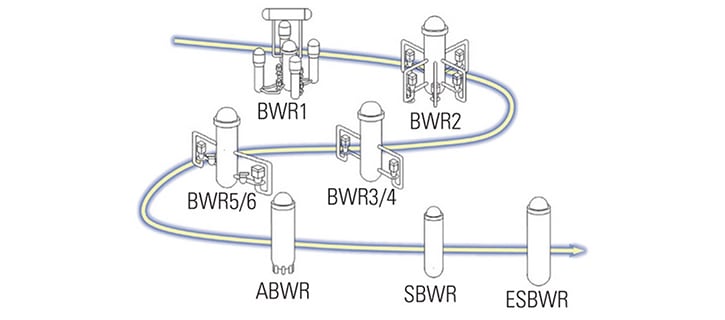GE Hitachi’s ESBWR Nuclear Reactor Gains Some Industry Support
GE Hitachi Nuclear Energy (GEH) and DTE Energy announced plans to explore advancing the detailed design of the Economic Simplified Boiling Water Reactor (ESBWR).
According to GEH, the ESBWR is the world’s safest approved nuclear reactor design based on core damage frequency. The reactor has advanced passive safety systems, and is designed to cool itself for more than a week with no onsite or offsite AC power, or operator action.
GEH applied for a Standard Design Certification with the U.S. Nuclear Regulatory Commission (NRC) on August 24, 2005. The NRC certified the ESBWR design on Sept. 16, 2014.
On May 1, 2015, the NRC issued DTE Energy the first-ever ESBWR-based combined construction and operating license. Although DTE has not committed to building a new nuclear unit, it is keeping the option open, for long-term planning purposes. The proposed reactor would be added to its Fermi site near Newport City in Monroe County, Michigan.
“DTE and GEH will further expand our cooperation by determining resource requirements and developing plans to advance the ESBWR design, enabling DTE Energy to be in a position to more readily begin work should the utility decide at a later date to add more carbon-free, base load power to its energy mix,” GEH’s COO Jay Wileman said. “We view this as a very positive and important step in the continued commercialization of the world’s safest reactor.”
The ESBWR program started in the early 1990s with GE’s Simplified Boiling Water Reactor (SBWR) design rated at 670 MW, which was augmented with features taken from the NRC-certified Advanced Boiling Water Reactor (ABWR). GE submitted the SBWR application for final design approval and design certification in August 1992, but withdrew the application in March 1996 because the power output of the SBWR was too small to produce acceptable economics for a new-build project.
Instead, it shifted its focus from the SBWR program to plants of 1,000 MW or larger, such as the ABWR and ESBWR (Figure 1). The ABWR was beginning to take hold in Japan, with the completion of four units and a couple more units under construction when the Fukushima disaster occurred, putting the brakes on the entire industry.
 |
1. An evolved design. Building upon proven technology, the ESBWR is a 1,520-MW Generation III+ boiling water reactor. Source: GEH |
The ESBWR is said to use about 25% fewer pumps and mechanical drives than reactors with active safety systems, and to offer the lowest projected operating, maintenance, and staffing costs in the nuclear industry on a per-kW basis. In addition to DTE, Dominion Virginia Power has selected the ESBWR as their technology of choice for a potential third reactor at its North Anna site. GEH said it expects the NRC to license that project in 2016.
—Aaron Larson, associate editor (@AaronL_Power, @POWERmagazine)